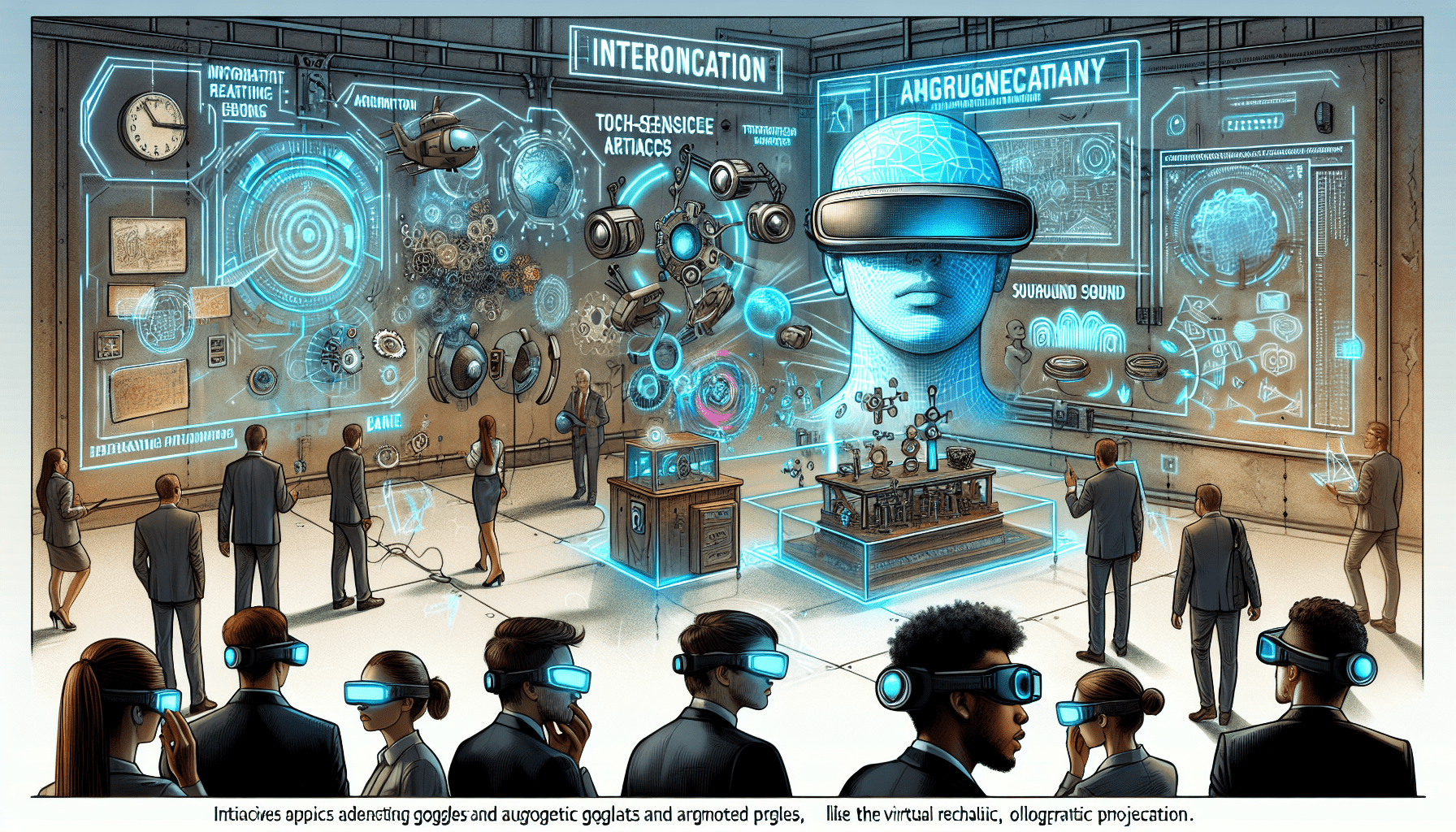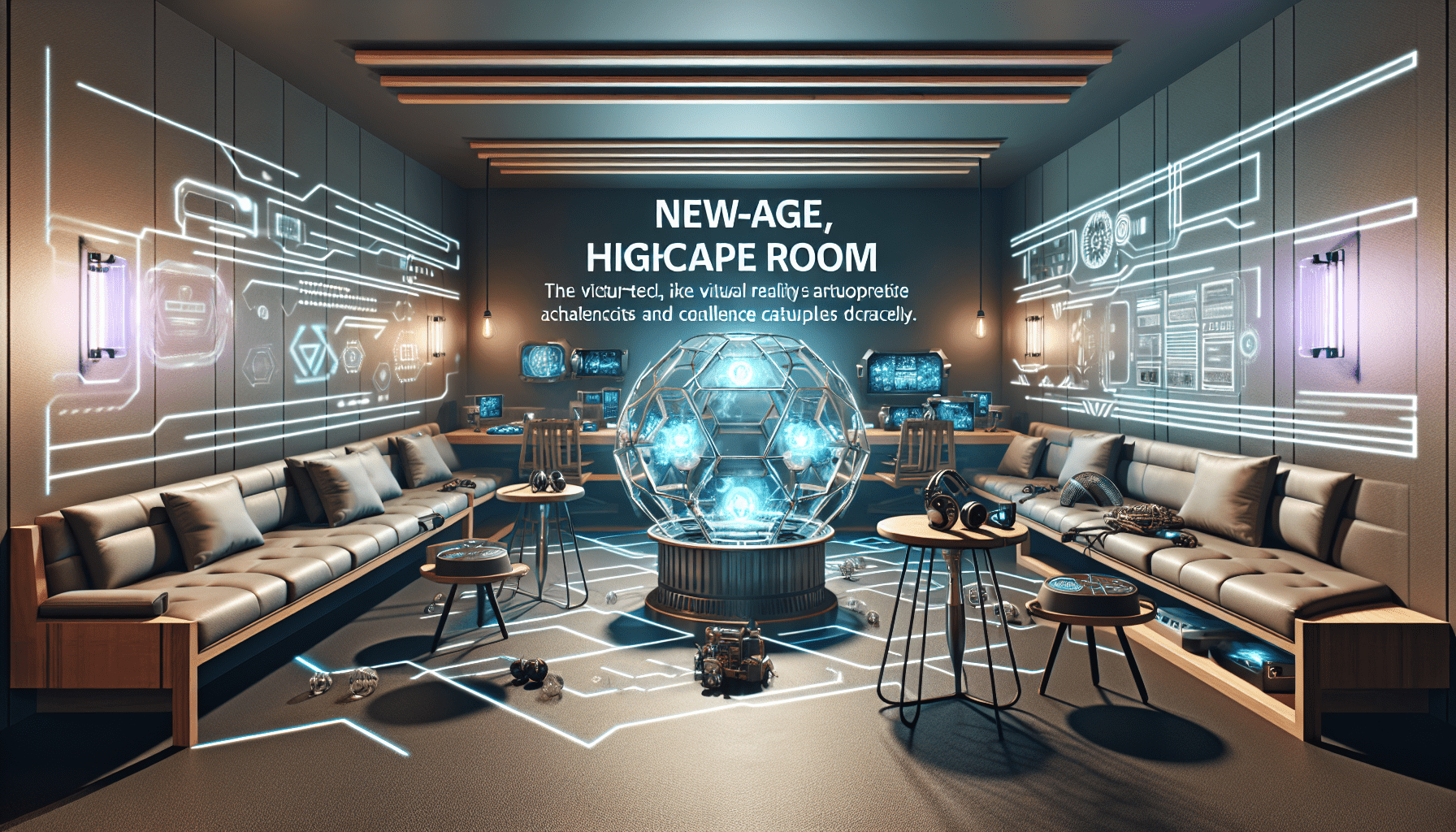Escape rooms have come a long way since their inception, transforming into immersive experiences that challenge your intellect and keep you on the edge of your seat. In this article, we will explore the exciting evolution of escape rooms and how they have evolved from simple puzzles to fully immersive adventures that transport you to another world. Get ready to discover the thrilling evolution that awaits you in the world of escape rooms.

Virtual Reality Integration
Escape rooms have come a long way since their inception, continually evolving to provide more immersive and captivating experiences for players. One of the latest trends in escape room design is the integration of virtual reality (VR) technology. By incorporating VR into escape rooms, players can be transported to entirely new worlds, enhancing their overall experience.
Immersive VR experiences
Virtual reality offers the opportunity to create truly immersive experiences within an escape room. With the use of VR headsets and controllers, players can step into a virtual world where their actions directly impact the outcome of the game. The level of immersion provided by VR technology allows players to feel as if they are truly part of the game’s universe, enhancing the sense of adventure and excitement.
Enhanced puzzles and challenges
Virtual reality integration opens up a whole new realm of possibilities when it comes to puzzles and challenges within escape rooms. By utilizing VR technology, escape room designers can create complex and dynamic puzzles that require players to interact with their virtual surroundings. These puzzles can range from manipulating virtual objects to solving intricate riddles, providing a unique and engaging gameplay experience.
Realistic environments
One of the key advantages of virtual reality integration in escape rooms is the ability to create realistic environments. Through the use of advanced graphics and audio technologies, players can be fully immersed in visually stunning and highly detailed virtual worlds. Whether it’s exploring ancient ruins, navigating through a futuristic cityscape, or adventuring in a fantasy realm, VR integration allows for an unparalleled level of realism that enhances the overall excitement and immersion of the escape room experience.
Interactive Storylines
As escape rooms continue to evolve, interactive storylines have become an essential component of the gameplay. These complex narratives not only engage players on a deeper level but also provide a sense of purpose to their actions within the game.
Complex narratives
Escape rooms with interactive storylines present players with intricate narratives that unfold as they progress through the game. Whether it’s a mystery to solve, a heist to pull off, or a supernatural event to unravel, the storyline adds depth and intrigue to the overall experience. Players are not simply solving puzzles but are also actively contributing to the unfolding story, creating a more engaging and immersive gameplay.
Branching pathways
To further enhance the interactive aspect of escape rooms, many designers are incorporating branching pathways into their games. These branching pathways allow players to make choices that directly impact the direction and outcome of the game. Whether it’s choosing which room to enter next or deciding how to overcome a particular challenge, the ability to influence the narrative gives players a greater sense of agency and investment in their escape room experience.
Character interactions
In addition to complex narratives and branching pathways, escape rooms are also incorporating interactive character interactions. Through the use of live actors or virtual avatars, players can interact with various characters throughout the game. These interactions may involve dialogue, collaboration, or even making decisions based on the information provided by the characters. By integrating character interactions, escape rooms create a more dynamic and immersive experience that goes beyond traditional puzzle-solving.
Collaborative Gameplay
Escape rooms have always been a popular choice for team-building activities and group outings. However, with the evolution of escape room design, collaborative gameplay has become a central focus, encouraging effective communication and coordination among players.
Team-based challenges
Escape rooms that promote collaborative gameplay often include team-based challenges. These challenges require players to work together, leveraging each other’s strengths and skills to solve puzzles and progress through the game. Whether it’s deciphering codes, coordinating actions, or completing tasks simultaneously, team-based challenges foster a sense of unity and cooperation among players.
Communication and coordination
To successfully complete team-based challenges, effective communication and coordination are essential. Escape rooms are increasingly incorporating elements that require players to communicate and coordinate their actions. This may involve sharing information, assigning roles and tasks, or even strategizing on the fly. By emphasizing communication and coordination, escape rooms encourage players to work together as a cohesive unit, improving teamwork and fostering a more enjoyable and rewarding experience.
Shared objectives
One of the key aspects of collaborative gameplay in escape rooms is having shared objectives. Instead of individual goals, escape rooms with shared objectives require players to collectively work towards a common goal. This encourages players to think beyond their own perspectives and consider the bigger picture, enhancing their ability to collaborate and problem-solve as a team. Shared objectives create a sense of camaraderie and achievement when players successfully overcome challenges together.
Augmented Reality Elements
While virtual reality has gained significant popularity, escape rooms are also exploring the integration of augmented reality (AR) elements. By overlaying digital information onto the physical environment, AR enhances immersion and offers new gameplay possibilities.
Overlaying digital information
AR integration in escape rooms allows for the overlay of digital information onto the physical world. This can be achieved through the use of smartphones, tablets, or AR glasses, providing players with additional clues, hints, or interactive elements. By seamlessly blending the virtual and physical realms, AR elements enhance the overall immersion and challenge players to explore their surroundings in new and exciting ways.
Integrating physical and virtual objects
Escape rooms incorporating augmented reality often blur the line between physical and virtual objects. By integrating physical items with virtual elements, players are presented with unique challenges that require them to manipulate and interact with both real and digital entities. This innovative approach not only enhances the gameplay experience but also encourages players to think creatively and adapt their problem-solving strategies.
Enhanced immersion
One of the significant advantages of augmented reality integration in escape rooms is the enhanced level of immersion it provides. By superimposing virtual elements onto the real world, players can feel as if they are part of a larger, interconnected universe. This level of immersion heightens the sense of adventure and excitement, making the escape room experience even more memorable and captivating.

Advanced Technology Integration
As technology continues to advance at a rapid pace, escape rooms are embracing smart devices, the Internet of Things (IoT), and innovative puzzle mechanisms to create increasingly immersive and challenging gameplay experiences.
Smart devices and gadgets
Escape rooms are incorporating smart devices and gadgets to enhance gameplay and interact with the game world. From using smartphones to scan QR codes or unlock hidden puzzles, to utilizing smart home devices to control lighting or trigger specific events, these technologies add an extra layer of interactivity and engagement. By integrating smart devices, escape rooms can create innovative and dynamic puzzles that keep players on their toes.
Incorporating IoT (Internet of Things)
The Internet of Things (IoT) is revolutionizing escape room experiences by connecting physical objects and devices to the digital world. By leveraging IoT technologies, escape rooms can create puzzles that require players to interact with various objects and devices, such as unlocking doors, manipulating lights, or activating hidden mechanisms. The integration of IoT adds a new level of complexity and interactivity to escape room gameplay, challenging players to think beyond the traditional puzzle-solving methods.
Innovative puzzle mechanisms
Escape rooms are continually pushing the boundaries of puzzle design, incorporating innovative mechanisms to challenge players in new and exciting ways. From mechanical puzzles that require physical manipulation to electronic puzzles that involve solving complex codes or hacking virtual systems, there is a wide variety of puzzle mechanisms that can be integrated into escape rooms. These innovative puzzle mechanisms not only provide unique gameplay experiences but also keep players engaged and enthralled throughout their adventure.
Thematic and Immersive Designs
Creating a captivating atmosphere is key to the success of an escape room. Thematic and immersive designs transport players into exciting and believable worlds, enhancing the overall experience and making it more memorable.
Detailed set and prop designs
Thematic escape rooms captivate players with their attention to detail in set and prop designs. Every aspect of the environment, from the furniture to the decor, is carefully crafted to reflect the theme of the room. This level of attention creates a sense of authenticity and immerses players in the storyline, allowing them to fully immerse themselves in the escape room experience.
Themed rooms and story settings
A significant component of thematic and immersive designs is the creation of themed rooms and story settings. Escape rooms are transforming physical spaces into intricately designed environments that transport players to different time periods, settings, or even fictional worlds. Whether it’s a Victorian-era mystery, a post-apocalyptic wasteland, or a space station, themed rooms and story settings provide players with a sense of adventure and wonder, enhancing their overall immersion and enjoyment.
Immersive sound and lighting effects
To further enhance the immersive experience, escape rooms employ immersive sound and lighting effects. By creating a carefully crafted audio landscape and utilizing dynamic lighting effects, escape room designers can create a sense of ambiance and suspense. The sound of creaking floors, dripping water, or distant footsteps, combined with atmospheric and strategically placed lighting, adds depth and realism to the escape room environment. These effects heighten anticipation, engage the senses, and create a more immersive and thrilling gameplay experience.

Flexible Difficulty Levels
Escape rooms are no longer solely for puzzle enthusiasts or avid gamers. With the goal of catering to a wide range of players, escape rooms are incorporating flexible difficulty levels, ensuring that everyone can enjoy the experience at their own pace and skill level.
Customizable challenges
Escape rooms embracing flexible difficulty levels often provide customizable challenges. This allows players to adjust the level of difficulty based on their skill and comfort level, ensuring a challenging yet enjoyable experience. Whether it’s adjusting the number of puzzles or the complexity of the riddles, customizable challenges give players the ability to tailor the game to their preferences, making it suitable for beginners and experts alike.
Adaptive difficulty based on player performance
Another approach to flexible difficulty levels is implementing adaptive systems that adjust the challenges based on player performance. As players progress through the escape room, the game recognizes their skill level and adjusts the difficulty of subsequent puzzles to match their abilities. This ensures that players are consistently challenged, regardless of their initial proficiency, promoting a fair and engaging gameplay experience for all participants.
Beginner-friendly options
In addition to customizable challenges and adaptive difficulty, escape rooms are also incorporating beginner-friendly options. These options often include additional hints or clues that can be accessed by players who may be struggling with a particular puzzle or challenge. By providing additional support, escape rooms aim to create a positive and inclusive environment where players of all skill levels can enjoy the game and feel a sense of accomplishment.
Expanded Target Audience
Escape rooms have traditionally catered to adult groups and puzzle enthusiasts. However, as the industry continues to evolve, escape rooms are expanding their target audience to include a wider range of players, including families, educational institutions, and various age groups.
Family-friendly escape rooms
Escape rooms designed for families aim to provide an enjoyable and age-appropriate experience for both children and adults. These rooms often incorporate puzzles and challenges that are suitable for different age groups, ensuring that everyone can actively participate and contribute to the game. Family-friendly escape rooms promote teamwork and collaboration between family members, creating a memorable and bonding experience for all.
Educational and learning-focused rooms
Escape rooms are increasingly being utilized as educational tools, offering immersive and interactive learning experiences. These educational escape rooms blend entertainment with educational content, allowing participants to learn and apply knowledge in a fun and engaging way. Whether it’s history, science, or problem-solving skills, educational escape rooms provide a unique and memorable learning opportunity that goes beyond traditional classroom settings.
Tailored experiences for different age groups
Recognizing that different age groups have varying interests and abilities, escape rooms are tailoring experiences to specific age groups. This ensures that the puzzles and challenges within the escape room are suitable and engaging for the target audience. From escape rooms designed for teenagers with more challenging puzzles to rooms specifically created for young children with simpler tasks, escape room operators are striving to provide tailored experiences that cater to the needs and preferences of different age groups.

Time-Limited VR Escape Rooms
For those seeking a more thrilling and fast-paced escape room experience, time-limited VR escape rooms offer an exciting alternative. These immersive games set players against the clock, introducing an additional layer of excitement and urgency to the gameplay.
Limited time to complete virtual challenges
Time-limited VR escape rooms challenge players to complete a series of virtual challenges within a set time limit. This adds an element of pressure and exhilaration, as players race against the clock to solve puzzles, find clues, and progress through the game. The time constraint forces players to think quickly and make decisions on the fly, creating an adrenaline-fueled and fast-paced experience.
Thrilling race against the clock
The thrill of a race against the clock is a key component of time-limited VR escape rooms. The countdown creates a sense of urgency and heightens the overall excitement, intensifying the gameplay experience. As players rush to complete tasks and unravel mysteries, the anticipation builds, creating a heart-pounding and immersive adventure that keeps players on the edge of their seats.
Intense and fast-paced gameplay
Time-limited VR escape rooms provide players with an intense and fast-paced gameplay experience. With the added pressure of time, players must think quickly, act decisively, and effectively coordinate with their teammates to reach their goal. The fast-paced nature of these escape rooms ensures a thrilling and adrenaline-fueled adventure that pushes players to their limits and leaves them with a sense of exhilaration and accomplishment.
Incorporating Gamification Elements
To enhance engagement and provide a competitive edge, escape rooms are incorporating gamification elements into their gameplay. By introducing score-based challenges, unlockable achievements, and leaderboards, escape rooms create a sense of competition and reward that motivates players to strive for success.
Score-based challenges
Escape rooms incorporating gamification often include score-based challenges. These challenges assign point values to different puzzles or accomplishments within the game. By accumulating points throughout the gameplay, players can track their progress and compare scores with other teams or players. Score-based challenges add an extra layer of competition and motivation, encouraging players to complete tasks quickly and efficiently to earn the highest score possible.
Unlockable achievements
To further enhance the competitive aspect of escape room experiences, escape rooms are incorporating unlockable achievements. These achievements are awarded to players or teams that accomplish specific tasks, solve challenging puzzles, or complete the game within a certain time limit. Unlockable achievements provide a sense of accomplishment and serve as a badge of honor, motivating players to revisit the escape room and strive for additional achievements or higher difficulty levels.
Leaderboards and competition
Escape rooms that embrace gamification often include leaderboards and competition features. These leaderboards display the scores and achievements of different teams or players, allowing them to compare their performance to others. By fostering a spirit of competition and friendly rivalry, leaderboards motivate players to improve their skills, strategize more effectively, and return to the escape room to attain the top spot on the leaderboard.
In conclusion, escape rooms are constantly evolving to provide players with more immersive, captivating, and engaging experiences. The integration of virtual reality, interactive storylines, collaborative gameplay, augmented reality elements, advanced technology, thematic and immersive designs, flexible difficulty levels, expanded target audience, time-limited VR escape rooms, and gamification elements all contribute to the evolution of escape room design. These innovative features and enhancements serve to create unforgettable adventures and ensure that escape room enthusiasts and newcomers alike can enjoy a thrilling and immersive gaming experience. Whether you’re exploring ancient ruins or solving a mystery in a futuristic world, the continuously evolving landscape of escape rooms guarantees excitement, challenge, and hours of immersive entertainment.
